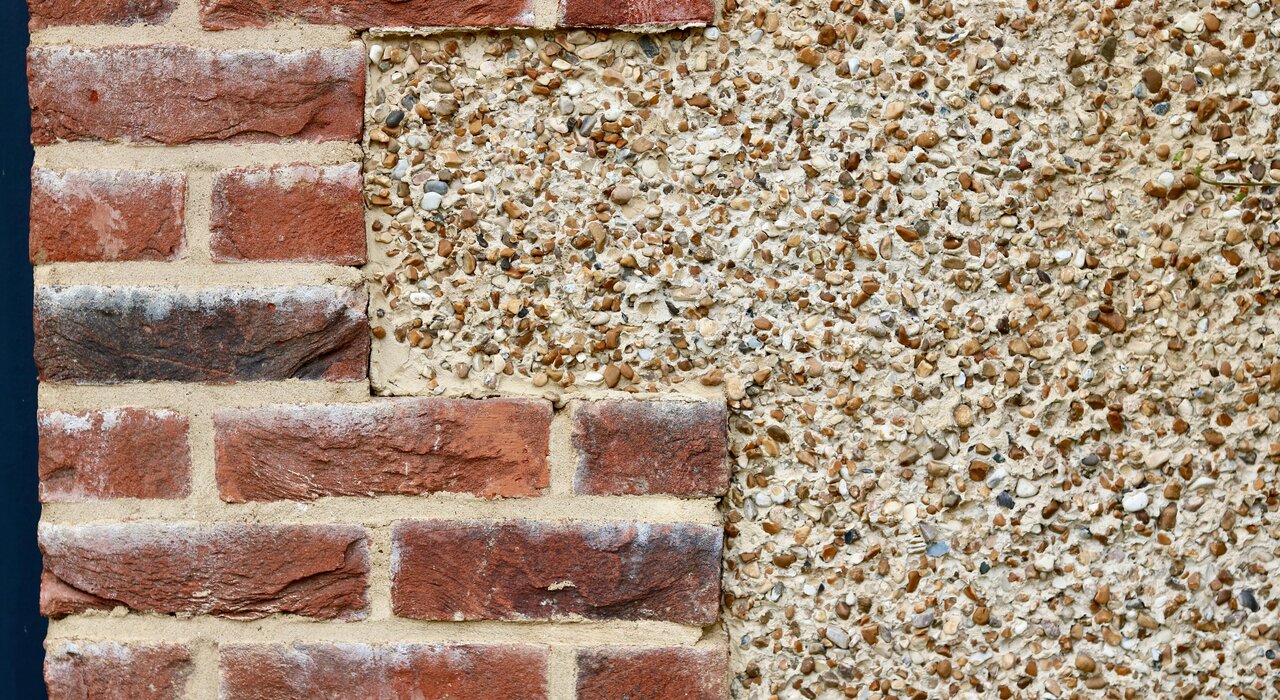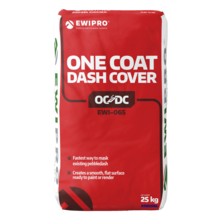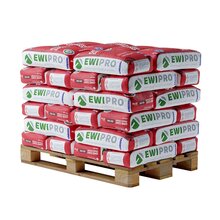
- What is pebbledash?
- Can you remove pebbledash?
- So, can you render over pebbledash?
- What if I like the pebbledash aesthetic?
- Replacing Pebbledash with Silicone Render 3mm
- Why should I render over my pebbledash with Silicone Render?
- Which Silicone Render should I choose to cover my pebbledash?
- Conclusion
Calling all pebbledash property owners! Looking for a way to spruce up the look of your home? Then you’re in the right place. Here at EWI Store, we offer various solutions for enhancing the aesthetics of any building, all while improving their thermal comfort, environmental performance and, ultimately, energy bills. We’re often asked how to best rid that outdated, dull pebbledash façade; as pebbledash removal can be extremely time-consuming and – not to mention – damaging to the property, it’s best to cover it entirely with a new render façade. In this blog, we’re going to explain exactly how you can go about covering pebbledash.
What is pebbledash?
Pebbledash, or roughcast, is a form of render consisting of a layer of mortar – typically sand and cement – and pebbles that are thrown onto the mortar while wet. It derived as a way to conceal the cheap-looking bricks that were made to build houses, but you will still find it on a plethora of properties up and down the country today. Arguably, the only benefit of pebbledash is that it is extremely durable; otherwise, especially in the UK, it is largely considered outdated, unappealing and, as such, an unpopular render choice.
Can you remove pebbledash?
Technically, you can remove pebbledash by hacking it off. However, not only will this inevitably damage the property, but there is no guarantee that it will achieve a nice, smooth finish. Due to its slap-dash nature, as you try to hack off stones, you will also inevitably hack off the mortar they are stuck to, exposing the underlying brickwork. Plus, after hacking it off, you would still need to apply external wall insulation before applying render to comply with building regulations.
So, can you render over pebbledash?
Absolutely! There are a couple of ways to render over pebbledash; one option is to apply OCDC over pebbledash. OCDC is specifically designed to be applied on top of pebbledash and can then be painted or rendered on top to achieve a smooth, modern look. OCDC is highly breathable, meaning it will allow any trapped moisture within the underlying pebbledash to escape. It can also be applied up to 25mm in one pass, therefore up to a maximum of 50mm after two coats, so it’s guaranteed to smooth over the pebbledash nicely and deliver a fresh, modern façade. Whether you’ve just bought a pebbledashed property or your existing pebbledash looks tattered, OCDC provides a solution for you.

What if I like the pebbledash aesthetic?
Well, for one: that’s a unique taste you have as pebbledash is certainly not a popular render choice anymore, but that’s okay. If your pebbledash aesthetic is looking tired and dull, but you are keen to update it, then you could have your property re-rendered with pebbledash. However, we have a much better option for you…
Replacing Pebbledash with Silicone Render 3mm
As mentioned earlier, another way to rid that pebbledash look on your home is to apply external wall insulation, then render over it. Nonetheless, if you are one of the few UK homeowners who like the pebbledash aesthetic, why not consider a Silicone Render finish with a 3mm-thick grain size? This way, not only will your house look more aesthetically pleasing in a colour of your choice – that’s right, our Silicone Renders are available in absolutely any colour with our colour-mixing facilities – but, in the thickest grain size available, the Silicone Render will also replicate that pebbly finish. A win-win!
Why should I render over my pebbledash with Silicone Render?
Where do we begin?! Covering your pebbledash with Silicone Render can:
- Dramatically enhance the aesthetics of your home
The primary reason for applying Silicone Render onto a property is to improve the aesthetics of the property. Silicone Render not only brightens a shabby wall but provides a facelift to the whole property. What’s more, Silicone Renders are highly breathable, so they will help to prevent problems with dampness and mould on your walls, which is especially beneficial in areas that are more exposed to organic matter. And, as well as the 3mm thickness, Silicone Render is available in 0.5mm, 1mm, 1.5mm and 2mm thickness, allowing you to achieve your desired textured finish.
- Massively improve the thermal performance of the building
If you’re also applying external wall insulation, that is. While applying OCDC followed by a render topcoat alone can provide insulating benefits, you can imagine how many more benefits external wall insulation underneath will provide! Typically, rendering a property costs £50-60 per square metre; external wall insulation with render costs around £100 per square metre. Therefore, if you’re going to invest in render, it’s worth going that extra mile and adding external wall insulation, saving more on energy bills in the long run.
- Greatly reduce the risk of penetrating damp
Another reason people choose to render their homes is to resolve issues with water ingress and penetrating dampness. Some forms of brick, especially in exposed areas, can be liable to damp if exposed to the elements over a long time. Applying render to the external walls blocks the path of water into the property and prevents dampness from occurring. Nonetheless, if you have cavity walls, this problem shouldn’t be occurring anyway.
Which Silicone Render should I choose to cover my pebbledash?
Here at EWI Store, we offer several types of Silicone Render:
- EWI-040 Silicone Silicate Render
- EWI-075 Silicone Render
- EWI-076 Premium Bio Silicone Render
- EWI-077 Nano Drex Silicone Render
All of these renders are manufactured by EWI Pro who specialise in providing long-lasting render solutions. Each Silicone Renders offers three main characteristics: they are hydrophobic (meaning they repel water), breathable and flexible; they rise in performance and quality from Silicone Silicate Render to Nano Drex Silicone Render.
Conclusion
So, what are you waiting for? If you have a pebbledashed property that is looking old and tired, then it might be time to consider using either OCDC followed by a render topcoat or an external wall insulation system with a render finish. We hope you found this blog useful in learning how to best cover your outdated pebbledash façade! If you have any more questions, do not hesitate to get in touch with our experienced Sales Team who will be happy to help based on their expertise. EWI Store are the leading UK render specialists, offering a range of high-quality Render and External Wall Insulation products. We take a whole-system approach to external wall insulation, stocking all the materials required to help installers achieve a stand-out result. Our selection of products is constantly growing as we strive to offer our customers the best possible choice of materials from trusted manufacturers and established brand names.

